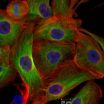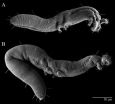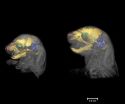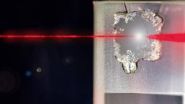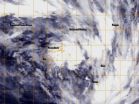(Press-News.org) Robert Avery, DO, MSCE, of Children's National Health System and colleagues are establishing innovative approaches with technology and medication to improve the vision of young children who have visual pathway glioma, a type of brain tumor.
Most optic pathway gliomas cause vision loss in children between one and eight years of age. As many as 20 percent of children with neurofibromatosis type 1 -- a genetic disorder that occurs in 1 in every 4,000 births – may develop these tumors. It is estimated that nearly half of those children may experience vision problems from their tumors.
Optic pathway gliomas can also occur sporadically, and not be related to neurofibromatosis type 1. Vision loss from these tumors can range from mild to complete blindness, and may be permanent if not properly treated. Unfortunately, standard treatment with front line chemotherapy typically results in modest improvements or stabilization of their vision.
Using Medications
In their study published in JAMA Ophthalmology, Avery and his colleagues report on four children with optic pathway gliomas that demonstrated marked recovery of vision when treated with the medication Bevacizumab. Other Children's National researchers included Roger J. Packer, MD, Senior VP of the Center for Neurosciences and Behavioral Medicine, and Eugene I. Hwang, MD, a neuro-oncologist.
Bevacizumab is an angiogenesis inhibitor, a drug that slows the growth of new blood vessels, to treat various cancers.
Bevacizumab provides a fast, robust response in these children," Avery told Reuters Health. "Although it's not first-line treatment, Bevacizumab is a good alternative or adjunct treatment."
Dr. Avery and colleagues identified children who had recovery of visual acuity or visual field in treatment with Bevacizumab.
A nine-year-old girl's visual acuity improved from 20/400 to 20/100 within six weeks of Bevacizumab treatment and remained stable for nine months after the treatment was discontinued, Avery wrote. Her visual field improved after two months of Bevacizumab monotherapy and her visual acuity returned to normal after four months of therapy. It remained stable at 12 months.
The standard front line treatment using cardioplatin-based chemotherapy typically produces only a modest benefit in visual acuity, Avery says.
"Given that most patients with OPG-related visual impairment will show modest or no visual improvement with standard treatment, the incorporation of Bevacizumab in these cases may greatly improve visual outcomes and should be considered in appropriate clinical situations," Avery says.
Handheld Technology
In another study in JAMA Ophthalmology Avery and other researchers found that using innovative technology, such as handheld optical coherence tomography (OCT), may help physicians improve their ability to evaluate children with optic pathway gliomas by capturing three-dimensional ultrahigh resolution (e.g., 3 microns…..one-half the width of a red-blood cell) images or their retinal axons. Avery's study was also reported in Reuters Health.
In that study, the other Children's National researchers included Packer, Hwang, Maria T. Acosta, MD, in neurology, Domiciano Jerry Santos, MD, in anesthesiology, sedation, and perioperative medicine, Dina J. Zand, MD, PhD, in the genetics program, Lindsay B. Kilburn, MD, in neuro-oncology, Kenneth N. Rosenbaum, MD, in genetics and metabolism, and Brian R. Rood, MD, clinical director of the neuro-oncology program.
In very young children with these tumors, it may be difficult to measure visual acuity especially if they have cognitive or behavioral difficulties. "The handheld OCT provides a safe, non-contact and objective measure of visual pathway integrity that does not rely on a child's cooperation," Avery says.
"We hope that our handheld OCT measures will someday improve our ability to detect and monitor tumor progression that cannot be discovered during a routine eye exam or MRI scan," Avery adds.
INFORMATION:
Contact: Emily Hartman or Joe Cantlupe, 202-476-4500
About Children's National Health System
Children's National Health System, based in Washington, DC, has been serving the nation's children since 1870. Children's National's hospital is Magnet® designated, and is consistently ranked among the top pediatric hospitals by U.S.News & World Report. Home to the Children's Research Institute and the Sheikh Zayed Institute for Pediatric Surgical Innovation, Children's National is one of the nation's top NIH-funded pediatric institutions. With a community-based pediatric network, eight regional outpatient centers, an ambulatory surgery center, two emergency rooms, an acute care hospital, and collaborations throughout the region, Children's National is recognized for its expertise and innovation in pediatric care and as an advocate for all children. For more information, visit ChildrensNational.org, or follow us on Facebook and Twitter.
Robert Avery, D.O., M.S.C.E., studies innovations to improve vision in children with tumors
2014-02-28
ELSE PRESS RELEASES FROM THIS DATE:
Tackling tumors with space station research
2014-02-28
In space, things don't always behave the way we expect them to. In the case of cancer, researchers have found that this is a good thing: some tumors seem to be much less aggressive in the microgravity environment of space compared to their behavior on Earth. This observation, reported in research published in February by the FASEB Journal, could help scientists understand the mechanism involved and develop drugs targeting tumors that don't respond to current treatments. This work is the latest in a large body of evidence on how space exploration benefits those of us on ...
Worm-like mite species discovered on Ohio State's campus
2014-02-28
COLUMBUS, Ohio – It looks like a worm and moves like a worm – sort of. But it is a previously unidentified microscopic species of mite that was discovered by a graduate student on The Ohio State University campus.
Affectionately dubbed the "Buckeye Dragon Mite" by Ohio State's Acarology Laboratory, the mite is officially named Osperalycus tenerphagus, Latin for "mouth purse" and "tender feeding," in a nod to its complex and highly unusual oral structure.
This mite doesn't resemble a mythological winged dragon, but the snake-like Chinese dancing dragons that appear in ...
3-D imaging sheds light on Apert syndrome development
2014-02-28
Three dimensional imaging of two different mouse models of Apert Syndrome shows that cranial deformation begins before birth and continues, worsening with time, according to a team of researchers who studied mice to better understand and treat the disorder in humans.
Apert Syndrome is caused by mutations in FGFR2 -- fibroblast growth factor receptor 2 -- a gene, which usually produces a protein that functions in cell division, regulation of cell growth and maturation, formation of blood vessels, wound healing, and embryonic development. With certain mutations, this gene ...
GOES-West satellite eyes soggy storm approaching California
2014-02-28
A swirling Eastern Pacific Ocean storm system headed for California was spotted by NOAA's GOES-West satellite on February 28. According to the National Weather Service, this storm system has the potential to bring heavy rainfall to the drought-stricken state.
The storm was captured using visible data from NOAA's GOES-West or GOES-15 satellite on Feb. 28 at 1430 UTC/6:30 a.m. PST was made into an image by NASA/NOAA's GOES Project at NASA's Goddard Space Flight Center in Greenbelt, Md. The storm's center appeared as a tight swirl, with bands of clouds and showers already ...
NASA satellite sees great freeze over Great Lakes
2014-02-28
At night, as cold settles in, lake ice creaks and groans. It's been excessively cold, and I camped exposed on the snow-swept surface. Other than the lack of vegetation and the sounds at night, you'd never know you were on a lake. It feels like an empty plain. In some places, you see pressure ridges where ice has pushed into itself, sticking up like clear blue stegosaurus plates. -- Craig Childs
Author Craig Childs is not describing an Arctic lake. He's describing the bitterly cold and frozen scene on Lake Superior, during his February 2014 trek on the ice near the coast ...
Ultra-fast laser spectroscopy lights way to understanding new materials
2014-02-28
Scientists at the U.S. Department of Energy's Ames Laboratory are revealing the mysteries of new materials using ultra-fast laser spectroscopy, similar to high-speed photography where many quick images reveal subtle movements and changes inside the materials. Seeing these dynamics is one emerging strategy to better understanding how new materials work, so that we can use them to enable new energy technologies.
Physicist Jigang Wang and his colleagues recently used ultra-fast laser spectroscopy to examine and explain the mysterious electronic properties of iron-based superconductors. ...
Detection of water vapor in the atmosphere of a hot jupiter
2014-02-28
Although liquid water covers a majority of Earth's surface, scientists are still searching for planets outside of our solar system that contain water. Researchers at Caltech and several other institutions have used a new technique to analyze the gaseous atmospheres of such extrasolar planets and have made the first detection of water in the atmosphere of the Jupiter-mass planet orbiting the nearby star tau Boötis. With further development and more sensitive instruments, this technique could help researchers learn about how many planets with water—like Earth—exist within ...
Smoke in the water: Understanding the effects of smoke compounds on seed germination
2014-02-28
Although seemingly destructive, wildfires help to maintain biodiversity and are an important element of many ecosystems throughout the world. Not only do fires discourage non-native and invasive species from becoming established, but the quick release of nutrients, heat, and compounds found in ash and smoke play an important role in the life cycle of the native flora. For plants that are adapted to ecosystems where fire is a regular occurrence—such as savannas, grasslands, and coniferous forests—exposure to fire may initiate seed germination or enhance plant growth.
Recent ...
The nature of color: New formula to calculate hue improves accuracy of color analysis
2014-02-28
A stroll through the produce aisle in your local grocery store exhibits a plethora of vivid colors. From opposing hues, like red apples next to green celery, to subtler variations, such as light to dark purple grapes, every color seems to hold its own unique attraction. Is there a way to precisely measure these hundreds of colors? This is a crucial question for scientists studying the biological importance of color in nature, but measuring color is much more challenging than measuring other characteristics, like size or weight. In recent work, University of Colorado researcher ...
Tropical Cyclone 16P forms near Fiji
2014-02-28
Tropical Cyclone 16P formed near Fiji after lingering in the region for several days as a tropical low pressure area. NOAA's GOES-West satellite captured an infrared image of the storm on February 28.
NOAA's GOES-West satellite image showed the center of Tropical Cyclone 16P to the northeast of Fiji and over Vanua Levu. Broken bands of thunderstorms wrapping from the north to the east and southeast reached Wallis and Fortuna, Samoa, Niue and Tonga.
At 0900 UTC/4 a.m. EST, Tropical Cyclone 16P was centered about 170 nautical miles/`95.6 miles/314.8 km northeast of Suva, ...
